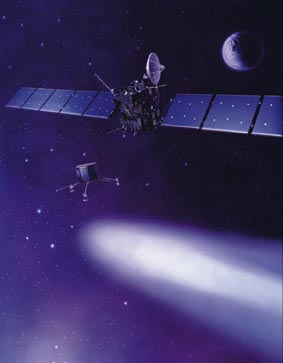Swedish Institute of Space Physics (IRF)
Institutet för rymdfysik (IRF) is a governmental research institute with 100 employees. Its primary task is to carry out basic research, education and associated observatory activities in space physics, space technology and atmospheric physics. The main office of IRF is located in Kiruna (geographic coordinates 67.84° N, 20.41° E).
IRF's participation
in ESA's Rosetta mission

(Picture: ESA)
The European Space Agency's Rosetta spacecraft will visit a comet called 67P/Churyomov-Gerasimenko, catching up with the comet in its elliptic orbit around the Sun in 2014 and following it closely for more than a year as it approaches the Sun. IRF participates with two instruments on board: an Ion Composition Analyser (ICA), provided by IRF in Kiruna, and a dual Langmuir probe (LAP), provided by IRF in Uppsala. These instruments concentrate on measuring the partly ionized gas and dust exhausted by the comet nuclei (about 4 km across) as it is heated by the Sun. The IRF instruments will be the first of their kind in long-time orbit around a comet. Previous missions, like the ESA spacecraft Giotto to comets Halley and Grigg-Skjellerup, have only by-passed comets at great speed, while Rosetta will move around Churyomov-Gerasimenko with a speed on the order of a meter per minute, giving unprecedented measurement opportunities. Rosetta was launched from Kourou in French Guiana on 2 March 2004.
| Launched: | 2 March 2004 |
| Destination: | Comet 67P/Churyomov-Gerasimenko |
| IRF instrument: | RPC-ICA, Rosetta Plasma Consortium: Ion Composition Analyser (PI: Rickard Lundin) |
| Contact: | Scientific information: Prof. Rickard Lundin, tel. +46-980-79063, Dr Hans Nilsson, tel. +46-980-79127 |
| Technical information: Kjell Lundin, tel. +46-980-79033 | |
| Satellite page: | Rosetta homepage at ESA |
Links:
- Ion Composition Analyser (ICA)
developed at IRF in Kiruna
- More details about the instrument, the software and the engineering efforts (in Swedish)
- Picture Gallery
- Langmuir probe (LAP) developed at IRF in Uppsala
- Rosetta Plasma Consortium (RPC)
[IRF-Kiruna] [Solar System Physics and Astrophysics programme]
Updated by Webmaster@irf.se
Last update was 2004-03-02
